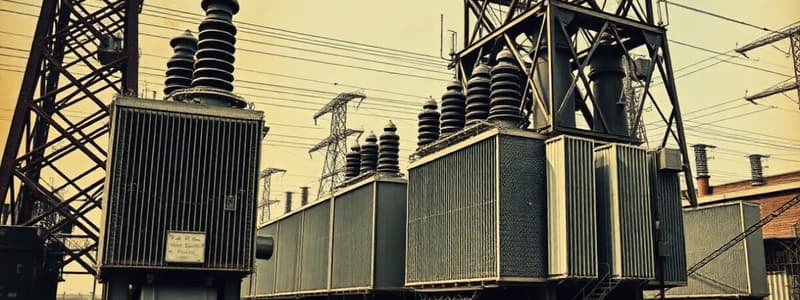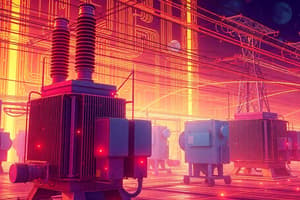Podcast
Questions and Answers
مقدار امپدانس یک مدار به شکل مستطیلی به صورت زیر بیان شده است: Z = 5-2,5J. مقدار جزء حقیقی (Real Part) امپدانس چیست؟
مقدار امپدانس یک مدار به شکل مستطیلی به صورت زیر بیان شده است: Z = 5-2,5J. مقدار جزء حقیقی (Real Part) امپدانس چیست؟
- 5 (correct)
- -2.5
- 0
- 2.5
فرمول V = IZ برای محاسبه جریان در مدار درست است.
فرمول V = IZ برای محاسبه جریان در مدار درست است.
True (A)
فرمول محاسبه جریان (I) با توجه به ولتاژ (V) و امپدانس (Z) چیست؟
فرمول محاسبه جریان (I) با توجه به ولتاژ (V) و امپدانس (Z) چیست؟
I = V / Z
امپدانس مشخص شده در قطعه Z = 5-2,5J به صورت _______ بیان شده است.
امپدانس مشخص شده در قطعه Z = 5-2,5J به صورت _______ بیان شده است.
زیر را با واحدهای مربوط به آنها مطابقت دهید:
زیر را با واحدهای مربوط به آنها مطابقت دهید:
Flashcards
Z = 5-2,5J
Z = 5-2,5J
مقاومت پیچیده مدار که در فرم مستطیلی نمایش داده می شود.
I = V/ Z = 10/ (5.59/-26.97°)
I = V/ Z = 10/ (5.59/-26.97°)
جریان عبوری از مدار که با قانون اهم (V=IZ) و به شکل مختصات قطبی بیان شده است.
V = I * Z
V = I * Z
یک فرمول ریاضی که رابطه بین ولتاژ (V)، جریان (I) و مقاومت (Z) را نشان می دهد.
Z = R + jX
Z = R + jX
Signup and view all the flashcards
Z = |Z|∠Θ
Z = |Z|∠Θ
Signup and view all the flashcards
Study Notes
Electrical Circuits and Machines
- Transformers: Devices that change AC voltage levels. They are used to increase or decrease voltage levels in electrical power systems. Transformers have a primary and secondary coil and operate based on electromagnetic induction.
- Types of transformers: Step-up transformers increase voltage, while step-down transformers decrease voltage. Autotransformers have a common winding for both primary and secondary coils.
- Transformer Tap Changers: Mechanisms that adjust transformer voltage levels. There are manual (non-automatic) and automatic types (OLTC).
AC Power System Components
- Power Generation: Power plants generate electricity. Common types include hydro, thermal (fossil fuel, nuclear), and renewable sources.
- Power Transmission: High-voltage lines transmit electricity over long distances. High voltage is used to minimize transmission losses.
- Power Distribution: Lower voltage lines distribute electricity to consumers.
Electric Machines (Motors and Generators)
- Motors: Convert electrical energy to mechanical energy. They use electromagnetic forces to create rotation. Motors have stator (stationary part) and rotor (rotating part).
- Generators: Convert mechanical energy to electrical energy. They employ electromagnetic induction to generate voltage. Common types include DC and AC Generators (alternators).
- Components Stator, Rotor, windings, brushes, commutator, and the magnetic field.
Electromagnetic Fields
- Magnetic Fields: Generated by electric currents. Defined by the magnetic flux density (B) and magnetic field intensity (H).
- Magnetic Flux: Measured in webers (Wb).
- Magnetic Field Intensity H: Measured in ampere-turns per meter (At/m).
- Magnetic Flux Density B: Measured in teslas (T).
- Relationship: B = μH. μ is the permeability of the material.
- Force on a current-carrying conductor in a magnetic field: F = iL x B (vector product)
Other Concepts
- Load (in Power Systems): The electrical demand placed on a power system by consumers. Load is often expressed in units like kilowatts (kW).
- Load Factor: The ratio of the average load to the maximum load over a given period. It indicates how efficiently a power system is utilized.
- Power Factor: The cosine of the phase angle between voltage and current in an AC circuit. It shows the proportion of apparent power that is contributing to useful work (active power).
- Active Power (P): The power that performs useful work (e.g., heating a resistor). It is measured in watts (W)
- Reactive power (Q): Power used for storing energy in the electric and magnetic fields of inductors or capacitors. It does not perform useful work. It's measured in volt-amperes reactive (VAR).
- Apparent Power (S): The total power in an AC circuit. It is the product of voltage and current. It's measured in volt-amperes (VA).
- Relationship: S² = P² + Q².
Studying That Suits You
Use AI to generate personalized quizzes and flashcards to suit your learning preferences.




